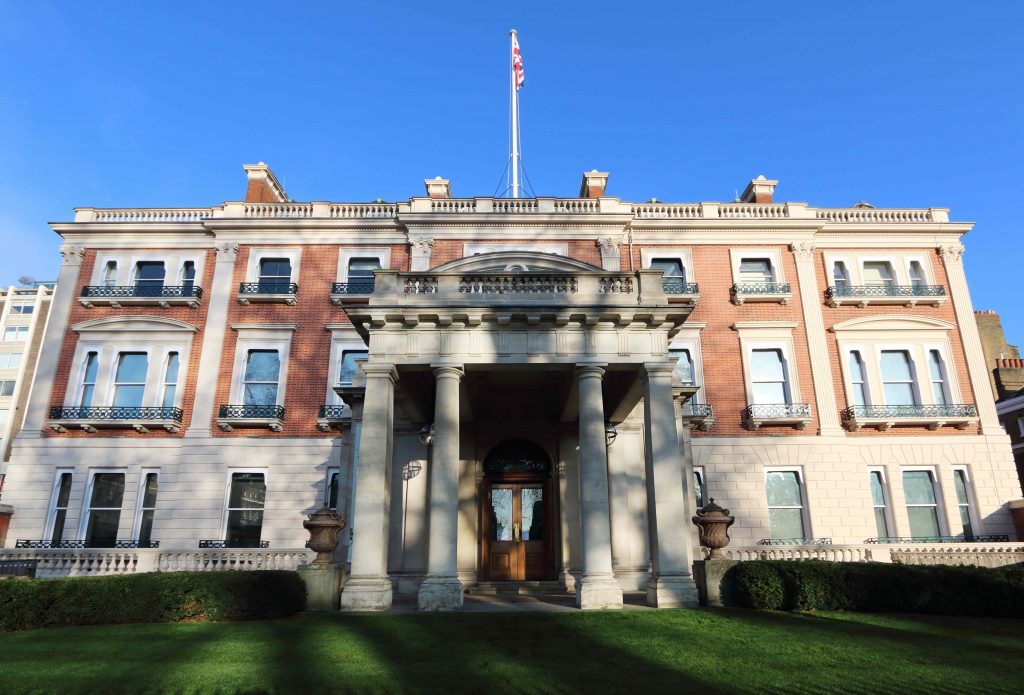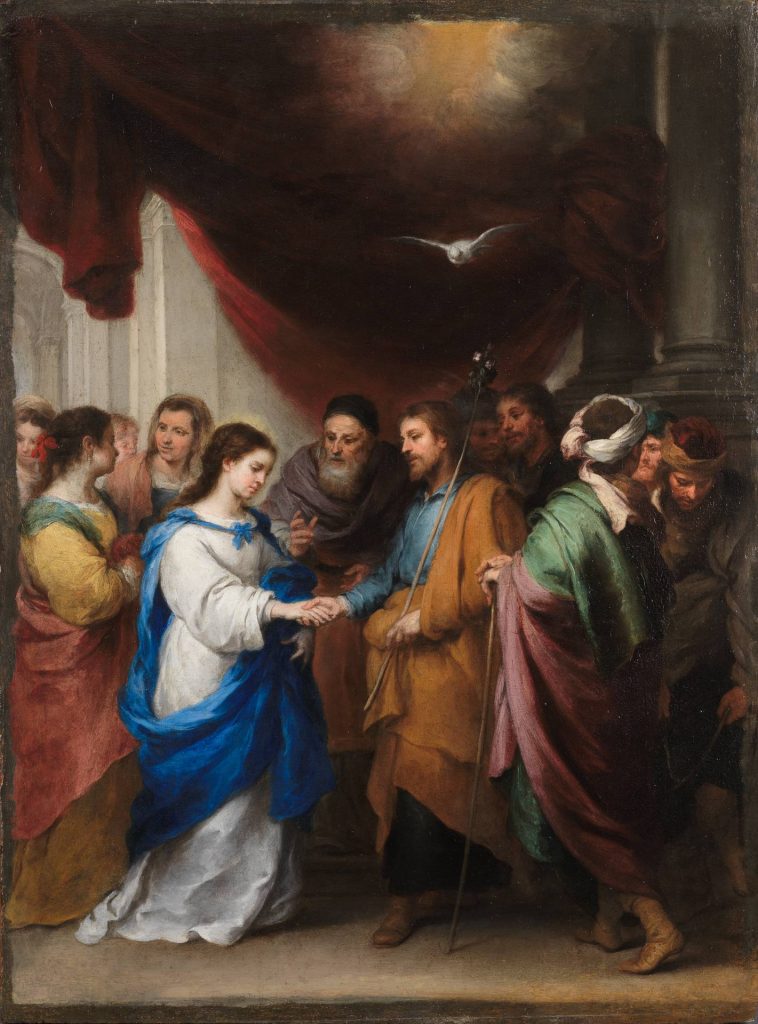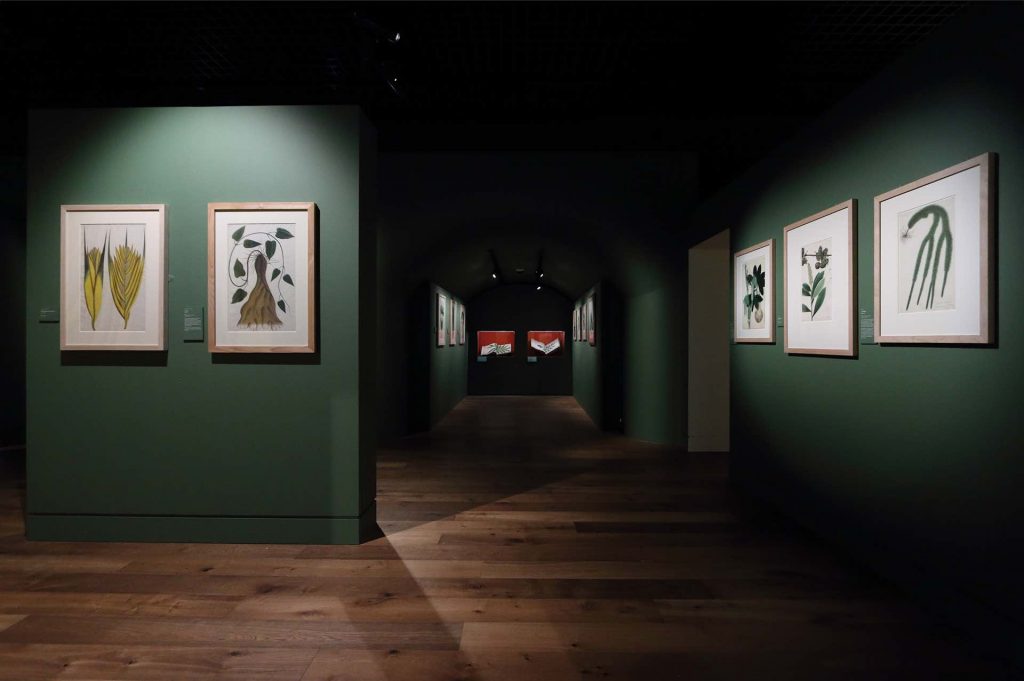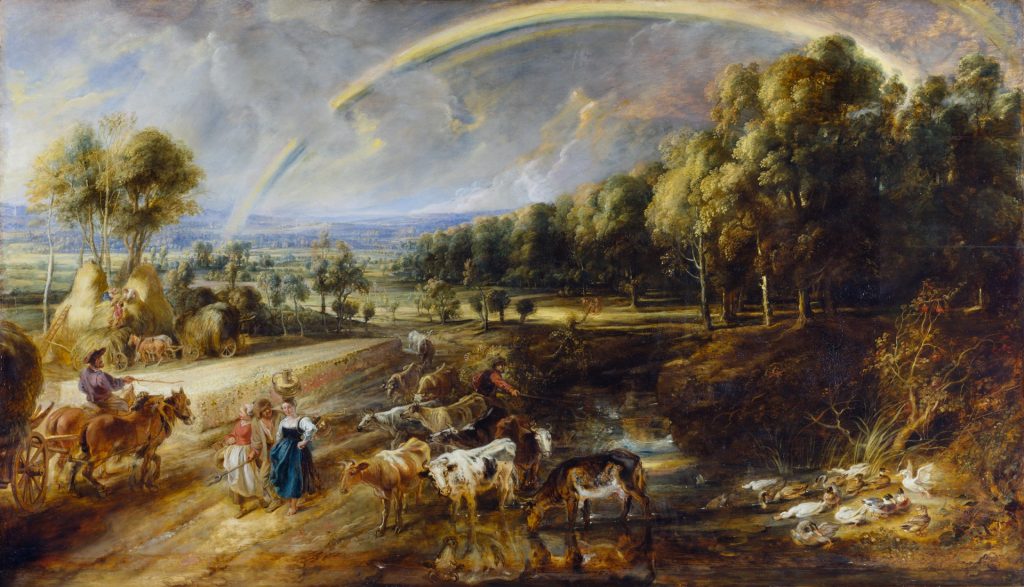“Me encanta cómo en España la gente es bastante paciente cuando estás aprendiendo la lengua”

Esta semana continuamos con la serie de entrevistas a personalidades del ámbito hispano-británico. Nuestro cuarto invitado, Xavier Bray, es un historiador del arte especializado en arte y escultura españolas. Es, además, el actual director de The Wallace Collection en Londres.
Previamente, Dr. Bray ostentó el título de comisario jefe de la Dulwich Picture Gallery y comisario adjunto de la colección de pinturas europeas de los siglos XVII y XVIII de la National Gallery de Londres. Además, ha sido comisario de diversas exposiciones tales como Lo sagrado hecho real: escultura y pintura españolas 1600 – 1700, Goya: retratos (2015) y, más recientemente, Ribera: arte de violencia (2018) .
Bray completó su tesis doctoral en 1999, titulada «Comisiones reales religiosas como propaganda política en la España de Carlos III«, en el Trinity College de Dublín.

– Durante los últimos cinco años, has trabajado como director de la Wallace Collection, ¿podrías resumir esta experiencia para nuestra audiencia?
La Wallace Collection es una colección increíble. Es uno de los mejores museos del mundo, con una impresionante diversidad de obras de arte, desde pintura y escultura hasta porcelana. Para mí, personalmente, ha sido una gran oportunidad el poder aprender sobre diferentes tipos de arte, sobre todo porque mi especialidad es solo la pintura barroca. He tenido un equipo de comisarios muy buenos, un equipo pequeño pero muy dinámico. Además, supongo que lo que estoy intentando hacer es convertir la Wallace Collection en un lugar que todo el mundo pueda disfrutar. Esa es nuestra misión más importante y nos estaba yendo bastante bien, hasta el inicio de la cuarentena.

– Eres un famoso especialista en arte de los siglos XVII y XVIII, por el cual es famosa la Wallace Collection. ¿Podríamos decir que estáis hechos el uno para el otro?
Es verdad que, cuando era estudiante, venía a analizar las colecciones de pintura, especialmente las de pintura española, francesa e italiana. Y entonces, por supuesto, realicé mi doctorado sobre Goya y la Wallace Collection es el lugar perfecto para estudiar pintores franceses del siglo XVIII. Te encuentras rodeado de Watteau, Boucher, Fragonard, Delacroix, Dolaroche y Meissonier. Es como volver al hogar que tan bien conocía. Es como si estuviéramos hechos el uno para el otro, pero a la vez, soy consciente de que quiero hacer más con otros tipos de arte e implicarme con diversas disciplinas, investigadores y técnicas. Pero, sí, por supuesto que ha sido una experiencia muy positiva trabajar en una colección tan rica y diversa.

¿Cómo se convirtió en especialista del Siglo de Oro español?
Mi padre trabajaba como periodista para el Wallace Street Journal en Madrid. Yo tenía alrededor de 14 años en ese momento. Desgraciadamente, yo me encontraba en un internado en Inglaterra mientras mis padres estaban pasándoselo genial en el Madrid de los 80, una gran década para España. Volví durante las vacaciones para pasar un tiempo en Madrid y El Prado fue el primer museo que descubrí. Allí encontré a Velázquez, Zurbarán, y después, al gran Goya. La verdad es que acercarme a la obra de éste, me ponía muy nervioso ya que le consideraba un artista complejo y difícil. Era muy variado, creando bellas pinturas de la vida de Madrid en sus cartones, pero a la vez tenía sus Pinturas Negras, que son el más perturbador testimonio de la humanidad fracasando.
– Habla un español excelente, ¿podría contarnos un poco más sobre cómo lo aprendió?
Aprendí español cuando tenía 16 o 17 años, en Inglaterra. Por suerte, mis padres estaban en Madrid y yo me esforzaba por practicarlo cuando estaba allí. Me encanta cómo en España la gente es bastante paciente cuando estás aprendiendo la lengua y no tienen problema en ayudarte. En España es realmente fácil sumergirse en la cultura, la tradición, las gentes, la propia lengua, la literatura, etc. También viví en Granada durante un año sabático. Simplemente el estar allí, vivir la vida y conocer a todo tipo de personas de diferentes círculos enriqueció realmente mi experiencia. El mejor consejo para estudiantes de lengua española es pasar en España el mayor tiempo posible.

– Usted dirigió el programa de conservación del Museo de Bellas Artes de Bilbao. ¿Cuáles son tus recuerdos de esa época ahora que estás en Londres?
Siempre he tenido especial afecto por Bilbao y este museo. Es un museo maravilloso de Bellas Artes. En aquellos días, trabajé para Miguel Zugaza. Allí trabajé mucho, gracias a él, pero también tuve la gran oportunidad de trabajar en un museo europeo y trabajar con una colección que incluyó a los grandes maestros además de una colección de pintura vasca del siglo XIX. Allí había un fuerte sentimiento de identidad nacional. Lo recuerdo con aprecio, me trae muy buenos recuerdos y siempre estoy pensando en formas de trabajar con el Museo de Bellas Artes de Bilbao.
– Usted tiene fama de apostar por la experimentación y de tomar riesgos en tu trabajo como comisario, ¿cómo puso este aspecto en práctica en la Wallace Collection?
Comisariar y organizar exhibiciones es algo que me apasiona. No me gusta repetir cosas y siempre intentaré impulsar las exposiciones y probar ideas nuevas, tratando de aportar nuevas perspectivas o artistas o períodos. Siempre trato de hacer más vital una exposición, aportando algo relevante en relación con aquello que esté ocurriendo en el presente. La exposición más reciente en la Wallace Collection, que en teoría sigue expuesta, es la primera muestra de obras de pintores indios encargada por oficiales de la East India Company, lo que supone un área de arte sin precedentes, nunca antes considerada.

– Nos acordamos especialmente de cómo rastreó la trayectoria de Goya desde sus principios en la corte de Carlos III en Madrid hasta sus años finales en Burdeos. ¿Cómo recuerda esta exposición?
Era una exposición de los retratos de Goya y no era tan obvio realizarla contando la historia de su vida a través de los retratos de gente que le habría conocido. Fue una de esas experiencias maravillosas. Reuniendo todos los amigos de Goya, así como reinas y políticos, pudimos reconstruir su vida de una manera muy diferente. No era sobre cómo Goya se veía a sí mismo, sino sobre las impresiones de personas que conoció y las conexiones que tuvo. Y, de repente, el resultado fue la capacidad de ver a Goya de una manera muy diferente. Y, para mí, y espero que para los visitantes también, fue una experiencia extraordinaria el entender los círculos en los que se movió y sus amistades; tienes la oportunidad de conocer a este hombre extraordinario y a su alma. Es raro poder hacer eso con un artista. Fue una experiencia muy satisfactoria y me hubiera gustado poder estar allí por la noche, para oír sus conversaciones. Fue una de esas exposiciones dinámicas, donde podrías esperar que los cuadros comenzaran a hablar.

La crisis del Covid-19 ha provocado el cierre de todos los museos. ¿Habéis lanzado algún programa en línea en la Wallace Collection para este periodo especial?
Por supuesto, como todo museo, queremos asegurarnos de no desaparecer. Estamos muy preocupados de que todo el mundo se esté centrando en muchas otras cosas, lo cual está bien, pero el mayor problema es cómo conseguir que un museo como la Wallace Collection siga siendo relevante hoy en día. Estamos lanzando una serie de temas digitales con los que la gente puede involucrarse en nuestra página web. Tengo la esperanza de, si acudir al lugar del trabajo es posible, volver a la galería y realizar una grabación en directo sobre la exhibición Indian Animals. Además, esperamos poder reabrir pronto y continuar con nuestro programa. Tenemos una exposición sobre Rubens dentro de poco que reúne dos de sus grandes paisajes por primera vez. Uno es Paisaje con arcoíris (de la Wallace Collection) que yo creo que se ha vuelto más emotivo que nunca en los últimos meses. El arcoíris se ha convertido un símbolo de esperanza en Reino Unido y del gran trabajo del NHS, así que espero que este cuadro tenga un fuerte impacto en nuestra sociedad como una imagen de supervivencia y creatividad. En realidad, este es un gran momento para la creatividad.
Traducción: Blanca Gomez Garcia
“I love that in Spain, people are quite patient when you are learning the language”

This week, we continue a series of interviews with personalities from the Spanish-British sphere. Our fourth guest, Xavier Bray, is an Art Historian specialising in Spanish art and sculpture. He is the current Director of the Wallace Collection in London.
Formerly, Dr Bray held the title of Chief Curator at the Dulwich Picture Gallery and Assistant Curator of 17th and 18th-century European paintings at the National Gallery, London. Furthermore, he has curated several exhibitions including The Sacred Made Real: Spanish Sculpture and Painting 1600-1700 (2009), Goya: The Portraits (2015) and, most recently, Ribera: Art of Violence (2018).
Dr Bray completed his PhD in 1999, (entitled, ‘Royal Religious Commissions as Political Propaganda in Spain under Charles III’) at Trinity College, Dublin.

– For the past five years, you have been the director of the Wallace Collection, could you summarise this experience for our audience?
The Wallace Collection is an unbelievable collection. It’s a world class museum, with such an incredible diversity of works of art, ranging from paintings and sculpture to porcelain. For me personally, it’s been a great opportunity to learn about the different arts, particularly as I am a specialist only in Baroque painting. I have a team of very good curators, it is a small team but very dynamic. And I suppose that what I am trying to do is to make the Wallace Collection a place for everyone to enjoy. That’s our most important mission and we were doing quite well, until the lockdown.

– You are a renowned specialist in 17th- and 18th-century art, for which the Wallace Collection is famous, could we say it is a perfect match?
It’s true that when I was a student I came to study the painting collections, particularly the Spanish, the French and the Italian. And then, of course, I did my PhD on Goya and the Wallace Collection is the perfect place to study the 18th-century French painters. You’re among the likes of Watteau, Boucher, Fragonard, Delacroix, Delaroche and Meissonier. It was like returning to a home that I knew well. It’s the perfect match, but at the same time, I am very aware of wanting to do more with the other arts and engage with different kinds of disciplines, scholars and techniques. But, yes of course it has been a very happy experience to work in such a rich and diverse collection.

– How did you become a specialist in Spanish Golden Age art?
My father was a journalist working for the Wall Street Journal in Madrid. I was about 15 at that time. Unfortunately, I was set to boarding school in England while my parents were having a great time in Madrid in the 1980s, a great decade for Spain. I came back for the holidays, to spend time in Madrid and the Prado was the first museum I discovered. There I found Velázquez, Zurbarán, and then, the great Goya, who I was actually very nervous of approaching, because I found him a very complicated and difficult artist. He was so mixed; simultaneously creating beautiful paintings of Madrid life in his cartoons and alongside the Black Paintings, which are the most disturbing testimonies of humanity going wrong.
– You speak Spanish excellently, could you tell me a bit more about it?
I learnt it when I was about 16 or 17 whilst in England. Luckily, my parents were in Madrid and I tried to practice it hard when I was there. I love that in Spain, people are quite patient when you are learning the language, and they help you out. It is very immersive in Spain, you can immerse in the tradition, with people, the language itself, the literature, etc. I also took a year off and I lived in Granada. It was just being there and living life and meeting all kinds of people from different circles that really enriched my experience. The best advice to students of the Spanish language is to spend as much time in Spain as possible.

– You lead the curatorial programme at the Museo de Bellas Artes in Bilbao. What are your memories of that time now that you are in London?
I have always been very fond of Bilbao and the museum there. It’s a great museum of Fine Arts. In those days, I worked with Miguel Zugaza. I learnt so much there, thanks to him, but I also had the great opportunity of working in a European museum, and to work with a collection which included old masters as well as a great collection of Basque paintings of the 19th-century. There was a strong national identity there. I remember it fondly, of good memories and I am always thinking of new ways to work with the museum of Fine Arts in Bilbao.
– You have a reputation for experimentation and risk-taking in curating, how did you put it into practice at the Wallace Collection?
Curating and organising exhibitions is something that I love. I do not like to repeat things and will always push exhibitions forward and try out new ideas, try to bring in a new angle or an artist or a period. I always try to make it pivotal for the exhibition to try to say something relevant as to what is going on at that moment in time. The most recent exhibition at the Wallace Collection, which in theory it is still on, is the first UK exhibition of works by Indian master painters commissioned by East India Company officials, and this is an unprecedented area of art, never before even considered.

– We especially remember how you traced Goya’s career from his early beginnings at the court of Charles III in Madrid, through to his final years in Bordeaux. How do you remember this exhibition?
It was an exhibition on Goya’s portraits and it was not an obvious one to do, to tell the story of his life through the portraits of people he would have known. It was one of those amazing experiences. By bringing in all of Goya’s friends, Queens and politicians, we were able to reconstruct his life in a very different way. It wasn’t about how Goya saw himself but about the impressions of him from people he knew and the connections he had. And suddenly, the result was an ability to see Goya in a very different way. And for me, and I hope for the visitors too, it was an extraordinary experience to understand the circles in which he moved and his friendships; you get to know this extraordinary man and his soul. It’s rare to be able to do that with an artist. It was a very satisfying experience and I wish I would have been there at night, to listen to their conversations. It was one of those vibrant exhibitions where you might expect the pictures to start talking.

– The covid-19 crisis has closed all the museums. Have you launched any online programmes at the Wallace Collection for this special period?
Of course, like every museum, we want to make sure that we don’t just disappear. We are very worried that everyone is fixating on so many other things, which is quite right, but the big thing is how to keep a museum like the Wallace Collection relevant today. We are launching a series of digital themes that people can engage with on our website. I am hoping, if commuting is possible, to go back to the gallery and do a live recording of the Indian Animals exhibition. Additionally, we hope to reopen soon and carry on with our programme. We have Rubens coming up, reuniting two of his great landscapes for the first time. One of them is The Rainbow Landscape (The Wallace Collection) which I feel has become more poignant than ever in the last few months. The rainbow has become a symbol of hope in the UK and of the great work of the NHS, so I am hoping that this painting will have a really strong impact on our society as a painting of survival and creativity. This is actually a great moment for creativity.


